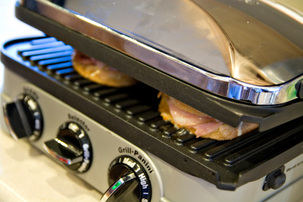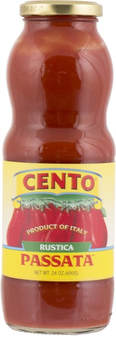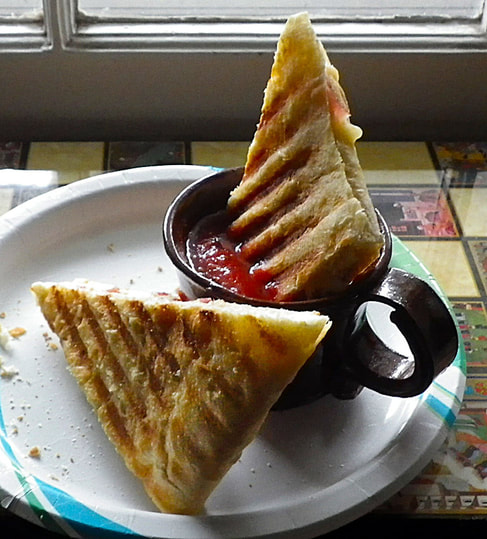 Our panini press Our panini press In Italy, there is a saying,"buono come il pane"... or, "It's as good as bread". This saying is used to compliment the best cooking. Think about it... that's how high Italians value a food as simple as bread, to compare other meals to it. You can't get simpler or better than the humble panino... During our Voyage throughout Italy, one of the simplest lunches was the affordable and cheap panino. We were making panini long before we went to my Babbo-land, but since we got back, I think they've gotten better and better. One of our favorite appliances is the Cuisinart GR-4N 5-in-1 Griddler. Lisa uses the flat plates for making pancakes and I use the grill plates to make panini. We buy ciabatta with olive oil from the supermarket and can make fantastic panini in about 5 minutes. A Short Panino History: The word "panino" literally means "little breads". In Latin, panis means bread. A panino doesn't really need to be heated, as in Italy it is often eaten as a quick snack on the run, in the field, or in the case of an Italian bachelor.... "Ehi! Mamma, make me a snack!". Stuff some peppers and ham inside a small bread roll and Mama gives her big "bambino" a satisfying, quick snack without much effort. (She thinks, "After he gets married, HE is going to look after ME.") This type more precisely is called a Panino imbottito, literally "stuffed little bread", i.e. a sandwich. Throughout early history, bread was considered an entire meal, until it became the support or container for a condiment or filling--the sandwich. The first reference of a panino appeared in a 16th-century Italian cookbook, with the first mention of "panini" appearing in 1954 in the New York Times in an article about an Italian festival in Harlem: "The visitors ate Italian sausage, also pizze fritta, zeppole, calzone, torrone, panini, pepperoni, and taralli." Panini as we know them today, became trendy in Milanese bars, called paninoteche, in the 1970s and 1980s. In fact, in Italy during the Eighties, a cultural fad developed in Milano where teens would meet in panino bars,... the teens were called paninnare. In Sicily, Panini cresciuti ("grown rolls") are fried Sicilian potato rolls containing ham and cheese. Today in Italy, shops that specialize in panini are called panineria, although many of these have morphed into offering a smörgåsbord of many types of sandwiches, not just the classic panino. In Italy, sandwich shops traditionally wrap the bottom of a panino in a sheet of white paper, a way to keep hands clean while making this a true finger food. Our Panino: This time I made our panini with slices of salami-mozzarella roll (Boar's Head brand "Panino" roll is nice and spicy, and they also have a Prosciutto version), becoming a commonplace item in the supermarket fresh cheese section. I learned in Italy that some of the best things can be very simple. This lunch is a good example of this philosophy. You can also get more creative too... using grated cheeses like fontina, asiago, smoked gouda or cacciacavalo and using leftover chicken, prosciutto, sausage, caramelized onions, olives, peppers... whatever. I highly recommend using a bit of smoked cheese which adds tons of flavor. Today's panino, however, was an ad hoc, simple lunch, like the ones I threw together in Italy. I cut the ciabatta in 5 inch long sections the sliced each horizontally and unfolded them to open. I then slice the salami-mozzeralla into slices a bit less than 1/4" thick and lay 4 on each ciabatta. Some say you need to butter the outside of your bread or brush it with olive oil to make grill marks or a crust, but I omit this step, preferring less fat intake. I prefer nothing on the outside makes for a crispier, less greasy crust. (This is a finger food, after all). Generally speaking, if you want to cook in an authentically Italian manner, don't use butter. Butter is rarely used in Italian cooking and is never spread on bread. Drizzle your ingredients with a little olive oil or perhaps a good balsamic, or even a decent store bought Italian dressing. I like to add slices of one large cherry tomato to give some moisture to my panini. Black olives are great also or other giardinaria (pickled veggies) are also a good choice. My son, Lucas loves sweet pimentos on his. Setting my panini press to "grill" and to high heat, I let it preheat for a couple of minutes and then loaded in the panini (I can only do 2 at a time of this size). I give it a good pressing at the beginning and try to position the bread (front to back... there's a sweet spot) so the press lid sits flat. After about 2-3 minutes, I give a final press--hearing the panini sizzle. I hold this press for about 30-40 seconds, pull them out, plate them and slice diagonally into triangles. With panini, the longer you press it and hear the ingredients sizzle, the more crunch you will have in your bread. Too many people think a panini is buttered and grilled bread with cold cuts put inside unheated, and many restaurants order packaged sandwich bread with grill marks factory-burned into their crusts, then use it to make make a normal sandwich, calling it a panini. Shame! A true panini must be pressed and heated to meld the ingredients (that's meld, not melt) into one cohesive, gooey mess of deliciousness. And take note, if you use cold cuts and sliced cheese, the cheese must be placed both on top and on the bottom--the melted cheese helps hold the bread together. A panini is not a sandwich... you should not be able to lift the bread off after it's been pressed and cooked.  Passata In Italy, a passata is the most basic of tomato sauces--in fact, it's usually the base of a good sauce recipe. Typically, you can buy passata in bottles in a supermercado or alimentari with "passada pomodoro" on the label. (Click HERE to try Cento brand Passata on Amazon) Passata is nothing more than uncooked, crushed and sieved fresh tomatoes--usually a very high quality tomato at that. What I made was quick-cooked version... with spices added. Also, this is not a "marinara" sauce. The Italian word "mare" means sea. A true marinara is a tomato sauce for or with a fish ingredient... clams, mussels, anchovies, etc. To about 1-1/2 cups of passata I added 1 teaspoon of dried oregano (use double of chopped fresh if you have it), plus 1 teaspoon of dried basil, a pinch of salt, a quick shake of pepperoncino (red pepper flakes) and 1 teaspoon of sugar. (The sugar is needed to cut the acid of the San Marzano tomatoes typically used to make passata). That's it. I stirred it, nuked it for 1 minute 45 seconds in the microwave and presto... a fantastic, fresh tasting dipping sauce! Enjoy... Buon Appetito! --Jerry Finzi Copyright, Jerry Finzi, Grand Voyage Italy, All rights reserved
0 Comments
Your comment will be posted after it is approved.
Leave a Reply. |
Categories
All
Archive
June 2024
|



 RSS Feed
RSS Feed
